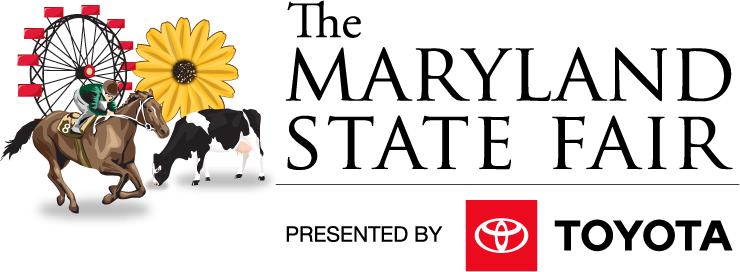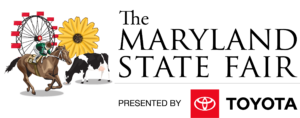In 1878, after several unsuccessful attempts to establish an on-going fair at other locations around Baltimore, a group of Maryland businessmen operated a successful fair on a four-acre site in Lutherville, MD. Despite its success, the Lutherville Fair was short lived because an extension of the Northern Central Railway was constructed in the middle of the fairgrounds.
Their success in Lutherville, however, gave the operators resolve to establish an annual fair, and in December 1878, they incorporated as The Agricultural Society of Baltimore County. The corporation leased a 37-acre plot of land on the York Turnpike on what was then known as “the Timonium Estate.” The first Fair at its new home was held September 9-12, 1879. The Northern Central Railway, the cause of the closing of the Lutherville Fair, was now the primary source of transportation for fairgoers from Baltimore to the Timonium Fairgrounds during the rest of the century. Other fairgoers walked or rode horses, wagons, carriages, and carts to the fairgrounds using the Turnpike.
Late in the century, The Agricultural Society of Baltimore County faced stiff competition from the Pimlico Fair, also referred to as the State Fair. Ultimately, the two groups held joint fairs in 1894 and 1897, and in 1906, merged to form one corporation – the Maryland State Fair and Agricultural Society of Baltimore County, Md. Their annual Fair became known as The Maryland State Fair.
The early years at the Fair saw tents and wooden structures in use to exhibit home arts, farm and garden products, and livestock shows. Plowing and working oxen competitions were some of the popular but few attractions. Races were held at the track, and results were forwarded to interested horsemen at Baltimore and Alexandria, VA, by way of carrier pigeon. Food concessions consisted of sandwiches made by the farmers’ wives, and amusements involved sideshows, sack races, and greased pole climbing.
The Maryland State Fair grew and prospered, adding many attractions and exhibits, including an airmail delivery at the 1918 Fair. The annual event continued until 1943 when the Fair was interrupted because of the war effort. The fairgrounds were leased to the U.S. Army for a storage depot and a vehicle repair center. After a three year absence, the Fair reopened it gates in 1946.
In the 1950’s growth in Baltimore County flourished, and certain business interests wanted to purchase the fairgrounds site for industrial development. The majority stockholder of the Corporation, the Maryland Jockey Club, agreed to sell. However, a group of agriculturists, business leaders, horsemen, and bankers formed the “Save the Maryland State Fair Committee.” The Committee raised over $600,000 to purchase the fairgrounds, ensuring that The Maryland State Fair at Timonium would continue to be Maryland’s premiere event at the end of each summer.
Another crisis was averted in the 1970’s. The Maryland Racing Industry took steps to have the Fair’s Thoroughbred racing dates transferred to other Maryland tracks. Fair Directors recognized that such a move would threaten the survival of the Fair. The “Committee of Friends of the Maryland State Fair” was established to strengthen the cooperation between Maryland agriculture and horse breeding interests – a relationship that had been a tradition in the State since the mid 1700’s. The Committee was successful in convincing the public and the Maryland Legislature of the value in keeping Thoroughbred racing a part of the Fair. The Committee also prepared expansion plans for the Fair, which resulted in a $5 million grant from the State of Maryland for building, modernization, and year-round use of the fairgrounds.
In its long and colorful history, the Maryland State Fair has grown from 37 acres to over 100 acres. Because of a commitment to continually improve and expand the event, Fair organizers found that they could no longer squeeze in more entertainment and attractions in what had become the traditional 10-day run. Thus, in 1999, the Fair added a day, making the Fair an 11-day event and in 2018 a 12-day event. Since then, the Fair has continues to answer the challenge of staying on top with an ever-evolving array of competitions, events, and attractions that have drawn more and more visitors without losing sight of the mission that had guided the event’s course since 1879: to encourage the educational growth of youth (among them 4-H and Future Farmers of America) by providing a venue where they can showcase their skills; and, to educate the general public regarding agriculture, its related fields and its importance to our future.
As many citizens become more removed from agriculture, the Fair has attempted to close the gap with 1999 additions of Agriculture Fair Tours of animal barns, Milk-It Traditional Cow Milking Lessons & the Birthing Center. The Birthing Center, one of the most popular venues at the Fair, has given thousands of fairgoers the opportunity to witness the birth of calves, piglets and hatching of chicks under the supervision of veterinarians and University of Maryland Agriculture professors and students.
The first two decades of the new millennium brought numerous, exciting updates and improvements to the Maryland State Fair and the Fairgrounds:
The Maryland State Fair never forgets that exhibitors are at the heart of the event. Technological advances helped make life easier and more environmentally friendly for thousands of exhibitors by replacing its paper Premium Catalogues with an online entry system.
The old Maryland State Fair 4-H Poultry & Rabbit Building was replaced with The Mosner Miller Building, which houses The Maryland Department of Natural Resources Exhibit Room and The Maryland State Fair Museum (open during the Fair) — a wander-land of ribbons, trophies, uniforms, souvenirs, photographs, memorabilia, and the Hall of [Maryland State Fair & Agricultural Society, Inc. Board] Presidents. During the off-season, the building is used as a rental facility for various meetings and events.
Maryland State Fair’s Midway Operators, Deggeller Attractions, reconfigured the Midway of rides, traditional fair foods and games to separate the big rides from the children’s rides. The separate Kidde Land ride area was well received. And, the Maryland Foods Pavilion, that for decades satisfied local palates with a variety of food fresh from Maryland farms and the Chesapeake Bay, expanded to include the Chesapeake Craft Brew & Wine Garden.
In 2016, the Maryland Jockey Club opened the Timonium Off Track Betting Center on the second floor of the Maryland State Fairgrounds historic Grandstand. The already existing off track wagering facility was renovated in to a spacious simulcast center.
Nick’s Grandstand Grill and Crab House, adjacent to the OTB, on the second floor of the Maryland State Fair Grandstand opened to provide year-round crafty and unique seafood and American cuisine.
Begining in 2018, a variety of beautification projects were started: The chain link fencing surrounding the Fairgrounds was replaced with attractive wrought iron style fencing; The Timonium Racetrack Paddock was expanded and renovated with a hand-crafted iron gate, post-and-rail fencing, and a large American Elm Tree planted in the center.
2020 started as a particularly sunny year with the planning and implementation of a variety of environmental stewardship efforts, among them: installing more than 7,000 solar panels, planting native to Maryland trees on site, and participating in community clean-up projects.
2020 took a quick turn for the world when the COVID-19 pandemic hit.
Starting in 2020, in our nation’s time of need, the Maryland State Fair &
Agricultural Society, Inc. helped combat the pandemic utilizing the
Fairgrounds and its facilities for state and county testing and vaccination
sites, multiple food drives, and American Red Cross emergency blood drives.
Since the emergence of the pandemic the Maryland State Fair & Agricultural
Society Board of Directors, management, and staff worked diligently to track
information, trends and options for dealing with the unprecedented public
health issues to determine if it was possible to proceed with the 2020 Maryland State Fair. It was with heavy heart that the decision to cancel
the traditional 139th Fair. Fortunately, approval was received from state
and county officials to allow the Maryland State Fair Youth and Open
Livestock Shows in which Maryland youth and open class exhibitors showed
their animals following all proper health protocols. The Maryland State Fair
& Agricultural Society was able to fulfill its mission to educate and
showcase Maryland agriculture by livestreaming many of the livestock shows
and events for the public.
In 2021, the 12 Best Days of Summer returned in full swing with the Midway,
buildings and barns were open to the public. The 140th Maryland State Fair
was welcomed by exhibitors and fairgoers across the state.
In 2022, the 141st Maryland State Fair changed from consecutive days to a
successful three long weekend format. If history is evidence, the Maryland
State Fair will continue to grow, to change when necessary, to uphold
tradition when possible, and to provide Marylanders with a place to play,
learn, and make memories and friends. The over half-million visitors each
year attest to what has become a favorite summer tradition – the 12 Best
Days of Summer – The Maryland State Fair. And, the exceptional Fairgrounds
and facilities provide a special place for the events that draw
approximately two million visitors each year.
Annually, the Maryland State Fair provides new family entertainment while
preserving traditional favorites, honors the talents of Maryland youth and
adults through competition and showcases, and provides fun, educational
opportunities to help promote Maryland’s leading industry, agriculture.
Since many people are generations away from the farm, the Maryland State
Fair expands and changes its exhibits to keep up with technological and
industry advancements. Among the many current exhibits are: the Maryland
State Fair Birthing Center, U-Learn Farm, the University of Maryland Dairy
and Wye Beef Herds exhibits, Horseland, Nature Play Space, and more
agricultural programs.
The non-profit 501 (c ) (3) Maryland State Fair & Agricultural Society, Inc.
continues its mission to support agriculture, education, preserve and
promote Maryland’s agricultural roots, and provide competitions and events
showcasing Maryland’s premier industry, agriculture.



